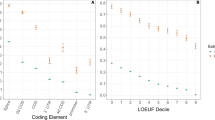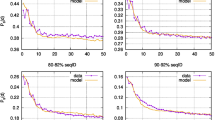Abstract
On the neutral mutation hypothesis1–3, the rate of nucleotide substitution is expected to be higher for functionally less important genes or parts of genes than for functionally more important genes, as the latter would be subject to stronger purifying (negative) selection2–4. On the other hand, selectionists believe that most nucleotide substitutions are caused by positive darwinian selection5,6, in which case the rate of nucleotide substitution in functionally unimportant genes or parts of genes2,7 is expected to be relatively lower because the mutations in these regions of DNA would not produce any significant selective advantages. Kimura8 and Jukes9 have argued that the higher substitution rate observed at the third positions of codons than at the first two positions supports the neutral mutation hypothesis, as most third-position substitutions are synonymous and do not change the amino acids encoded, although others5,10 have discussed the possibility that third-position substitutions are subject to positive darwinian selection. Recently, Kimura11 noted that the mouse globin pseudogene, ψα3, evolved faster than the normal mouse α1 gene, although he did not compute the substitution rate. Here, we present a method of computing the rate of nucleotide substitution for pseudogenes, and report that the three recently discovered pseudogenes show an extremely high rate of nucleotide substitution. As these pseudogenes apparently have no function, this finding strongly supports the neutral mutation hypothesis.
This is a preview of subscription content, access via your institution
Access options
Subscribe to this journal
Receive 51 print issues and online access
$199.00 per year
only $3.90 per issue
Buy this article
- Purchase on Springer Link
- Instant access to full article PDF
Prices may be subject to local taxes which are calculated during checkout
Similar content being viewed by others
References
Kimura, M. Nature 217, 624–626 (1968).
King, J. L. & Jukes, T. H. Science 164, 788–798 (1969).
Kimura, M. & Ohta, T. Proc. natn. Acad. Sci. U.S.A. 71, 2848–2852 (1974).
Dickerson, R. E. J. molec. Evol. 1, 26–45 (1971).
Clarke, B. Science 168, 1009–1011 (1970).
Milkman, R. Trends biochem. Sci. 1, N152–N154 (1976).
Jukes, T. H. & King, J. L. Nature 231, 114–115 (1971).
Kimura, M. Nature 267, 275–276 (1977).
Jukes, T. H. J. molec. Evol. 11, 207–209 (1978).
Richmond, R. C. Nature 225, 1025–1028 (1970).
Kimura, M. J. molec. Evol. 16, 111–120 (1980).
Proudfoot, N. J. Nature 286, 840–841 (1980).
Nishioka, Y., Leder, A. & Leder, P. Proc. natn. Acad. Sci. U.S.A. 77, 2806–2809 (1980).
Proudfoot, N. J. & Maniatis, T. Cell 21, 537–544 (1980).
Lacy, E. & Maniatis, T. Cell 21, 545–553 (1980).
Nishioka, Y. & Leder, P. Cell 18, 875–882 (1979).
Heindell, H. C. et al. Cell 15, 43–54 (1978).
Jukes, T. H. & Cantor, C. H. Mammalian Protein Metabolism (ed. Munro, H. N.) 21–123 (Academic, New York, 1969).
Michelson, A. M. & Orkin, S. H. Cell 22, 371–377 (1980).
Perler, F. et al. Cello 20, 555–566 (1980).
Kafatos, F. C. et al. Proc. natn. Acad. Sci. U.S.A. 74, 5618–5622 (1977).
Miyata, T. & Yasunaga, T. Proc. natn. Acad. Sci. U.S.A. 78, 450–453 (1981).
Author information
Authors and Affiliations
Rights and permissions
About this article
Cite this article
Li, WH., Gojobori, T. & Nei, M. Pseudogenes as a paradigm of neutral evolution. Nature 292, 237–239 (1981). https://doi.org/10.1038/292237a0
Received:
Accepted:
Published:
Issue Date:
DOI: https://doi.org/10.1038/292237a0
This article is cited by
-
Four classic “de novo” genes all have plausible homologs and likely evolved from retro-duplicated or pseudogenic sequences
Molecular Genetics and Genomics (2024)
-
Individual and population diversity of 20 representative olfactory receptor genes in pigs
Scientific Reports (2023)
-
Origin, evolution, and tissue-specific functions of the porcine repetitive element 1
Genetics Selection Evolution (2022)
-
Amino acid transporter (AAT) gene family in foxtail millet (Setaria italica L.): widespread family expansion, functional differentiation, roles in quality formation and response to abiotic stresses
BMC Genomics (2021)
-
Gene loss through pseudogenization contributes to the ecological diversification of a generalist Roseobacter lineage
The ISME Journal (2021)
Comments
By submitting a comment you agree to abide by our Terms and Community Guidelines. If you find something abusive or that does not comply with our terms or guidelines please flag it as inappropriate.



